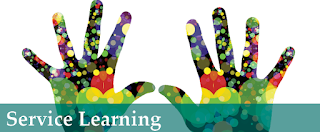Service Learning
Service learning is a way for students to
learn through project-based lessons. This type of learning has been worked to
engage and include all types of students. Service learning also falls under the
category of social justice education. How, you might ask?
In the article “Banners for Books: ‘‘Mighty-Hearted’’ Kindergartners Take Action through Arts-Based Service Learning”, they write, “In arts-based service learning the arts are both a creative means and a teaching method, empowering students to share their ideas through artistic expression. This action can bring people together around an issue, creating a common vision and the possibility to transform the landscape of the community in need.”
Art-based service learning can be an advocate for the arts and prove that students can put their practices into play and better a community. In the 2000s, art classes were drastically being cut and/or limited in schools across the nation. It is important to advocate for art by showing your administration and community its benefits.
When I was in school we started a community garden at my middle school. This was an interdisciplinary project that was fun to take part in. After a while, though it was just used by science classes, and I never really got to see anything get produced. What would have been nice is to see it be utilized by low-income people in our community or even fresh food to be used for school lunches. The art classes could have built a public art sculpture for it that represented community and helping others. They could have even utilized the plants to learn how to draw from life.
In the article “Eighth-Graders as ROLE MODELS:
A Service-Learning Art Collaboration”, they explored the learning objectives of
leadership and being a role model. Eighth Grade students got the opportunity to
take part in an SEL lesson with Kindergarteners. The result was great for
middle schoolers, as they are at an age where they can benefit from both
service learning and SEL greatly. Many students are changing and learning about
who they are at this age so it was beneficial for them to take charge and
reflect on the positive qualities about themselves. Service learning has a
great impact on students and should be developed in schools everywhere.
A service learning project that I would consider doing would be a partner project where high schoolers would create art with elementary students by layering blind contour self-portraits on top of each other. The end product would show unity and community. They older students would get to work on leadership qualities while the younger students would get fun mentors to look up to.



I love how you advocate for service learning in schools! Framing art in this context of creating well-rounded humans and connecting them to their communities helps to promote arts education. This is something I wish I had in art classes when I was growing up. At my school, art class could be better described as "study hall with art supplies". Rarely was there any lesson plan or due dates. I believe this set up is what gives the arts a bad rep in schools for being dispensable. Had my art classes involved service learning as you explained it, I would have gotten to know my peers better and felt that I had a voice in the community. I also feel the community as a whole would embody more open-mindedness and acceptance of differences.
ReplyDeleteGreat point about thinking about the "whole child". we know that we can't get kids to learn academics if their basic needs are first not being met. We need to make sure kids are emotionally ready to be learning so they can focus on our teaching and not be working through difficult feelings and unidentifiable emotions. Next week we are talking about service learning in here- but your connection from SEL to service learning is great. How can older students or community members be a role model for students as they learn to cope and deal with emotions and tough times? So many connections!
ReplyDelete